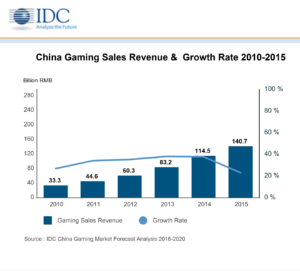The annual E3 Conference was held in June 2016 in Los Angeles. The Entertainment Software Association (ESA) announced that more than 70,000 people convened to experience the latest in video games and virtual reality (VR). The premier global video game event displayed more than 1,600 products from more than 250 exhibitors.
“The innovation and creativity on display will propel our industry to new heights and expand opportunities for remarkable growth.” said Michael D. Gallagher, president and CEO of ESA, the trade association that represents the U.S. video game industry and owner of E3.
Some of this growth will inevitably come from global markets, including China. According to IDC’s China Gaming Market forecast, gaming sales revenues in China reached US$21 billion in 2015, up by 22.1% year-on-year. During the year, the number of gaming users in the country stood at 537 million person-times, with a per capita value of contribution of US$39. Gaming has now become a topic that cannot be ignored in China’s ICT market. So, what kind of opportunities and challenges will E3 bring to China’s gaming market?
At E3 2016, Sony announced a debut lineup of more than 50 VR games and released the VR versions of its Resident Evil 7: Biohazard, Final Fantasy XV and other major gaming works, bringing the atmosphere at the exhibition to a climax. Oculus and HTC also showcased their Minecraft, Fallout 4 and a series of new VR works. Meanwhile, IDC research shows that screenless viewers will make up 74% of the global VR market in 2016 and more mobile gaming developers will enter this market. So far as the console, computer and mobile ends are concerned, VR has become the best opportunity for new gaming companies to introduce themselves.
New gaming consoles
Though various console details have yet to be finalized, Sony officially announced at E3 2016 the sales dates for its VR controller Aim and PSVR. Microsoft unveiled its Project Scorpio to support 4K games. Another speculation is that Nintendo may launch a new gaming console that supports VR. The release of new consoles include higher configurations, higher speed and stronger performance to come into step with the hottest VR tide at the moment. IDC research shows that gaming console shipment in China fell short of 600,000 units in 2015. Given a global market of tens of millions of consoles, gaming console vendors will have huge opportunities. However, constrained by China’s market policy and regulation, gaming console vendors also face serious challenges.
Gaming notebooks growing market share
More and more games – such as Resident Evil 7: Biohazard, Gears of War 4, Tekken 7 and others – can now be played on computers. Together with the rise of Steam platforms in recent years, games are increasingly being transferred from traditional household gaming machines to the computer platform. There are fewer games developed exclusively for gaming consoles. According to IDC’s gaming notebook tracker, gaming notebooks now account for a growing share of notebook consumption. In 2015, gaming notebook shipment in China reached 2.3 million units, approximately 4 times of gaming console shipments.
According to Neo Zheng, Research Manager at IDC China, “China’s gaming market is growing at double digits every year. With the development of the console market, the rise of gaming computers and the strong showing of VR, China’s gaming vendors must place their bets on platform and development priorities. As more consumers try out the new technologies, new opportunities and challenges will arise. E3 started the winds blowing and we predict the gaming storm will grow in velocity and excitement over the next few quarters.”

